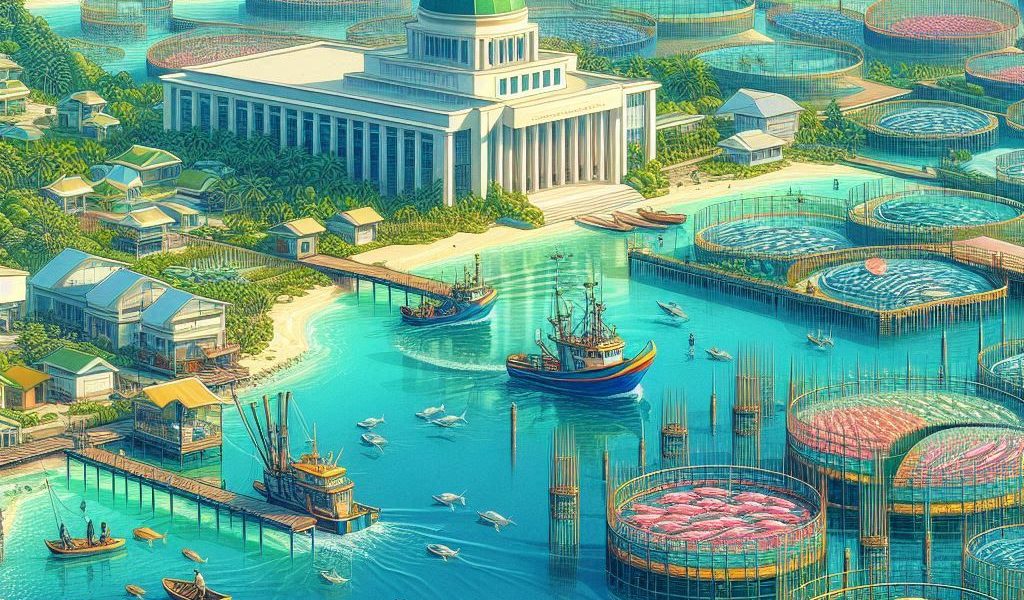The blue economy refers to the sustainable use of ocean resources for economic growth, improved livelihoods, and jobs while preserving the health of marine and coastal ecosystems. Among the most important sectors within the blue economy are fisheries and aquaculture, which provide food, employment, and income for millions of people across the globe. In India, the government recognizes the importance of these industries and offers various fisheries and aquaculture grants to encourage the growth and development of sustainable practices.
In this blog, we will explore the government grants and schemes available for fisheries and aquaculture, the importance of these sectors in the blue economy, how these grants help boost the industry, and how you can apply for these subsidies and support programs.
What Are Fisheries & Aquaculture Grants?
Fisheries and aquaculture grants are financial assistance programs offered by the government to support the growth and development of the fisheries and aquaculture sectors. These grants aim to improve the livelihood of people involved in these industries, ensure food security, promote sustainability, and boost overall economic growth in coastal and rural areas.
Aquaculture, or the farming of aquatic organisms such as fish, shellfish, and aquatic plants, has gained significant traction due to the increasing demand for seafood and the need for sustainable production systems. Meanwhile, the fisheries sector involves the collection of wild fish and other aquatic organisms from oceans, lakes, and rivers, supporting both domestic consumption and exports.
Importance of Fisheries & Aquaculture in the Blue Economy
The fisheries and aquaculture sectors play a crucial role in the blue economy for several reasons:
1. Food Security
Fisheries and aquaculture provide an essential source of protein and nutrition for millions of people around the world. Fish is an affordable and healthy food option, rich in essential nutrients such as Omega-3 fatty acids, vitamins, and minerals.
2. Livelihood Generation
The fisheries and aquaculture industries support millions of livelihoods, particularly in coastal and rural areas. Jobs range from fishers and aquaculture farmers to processors, traders, and exporters.
3. Economic Growth
India’s fisheries and aquaculture industries contribute significantly to its GDP and foreign exchange earnings through seafood exports. The government’s support through subsidies, grants, and schemes is pivotal in enhancing the sector’s growth.
4. Environmental Sustainability
Sustainable practices in fisheries and aquaculture are vital for the health of aquatic ecosystems. Grants and subsidies help promote practices that reduce overfishing, prevent habitat destruction, and ensure long-term viability.
Government Grants & Subsidies for Fisheries & Aquaculture in India
The Indian government, through various ministries, offers grants and subsidies to support the growth and development of the fisheries and aquaculture sectors. These schemes are designed to improve infrastructure, increase production, enhance technology, and promote sustainable practices. Some of the key government schemes and grants available for these sectors include:
1. Pradhan Mantri Matsya Sampada Yojana (PMMSY)
The Pradhan Mantri Matsya Sampada Yojana (PMMSY) is one of the most significant government schemes launched by the Ministry of Fisheries, Animal Husbandry, and Dairying. PMMSY aims to modernize the fisheries sector, improve production, and promote sustainable fishing and aquaculture practices.
- Objective: To enhance fish production, increase the income of fishers and fish farmers, and boost sustainable aquaculture practices across the country.
- Key Features:
- Financial support for setting up fish farms, hatcheries, and fish processing plants.
- Implementation of modern fishing technologies to increase productivity.
- Promotion of integrated multi-trophic aquaculture and marine fisheries development.
- Eligibility: Fishers, fish farmers, and entities involved in the fisheries value chain, including fish traders, processors, and exporters.
- How to Apply: Applicants can apply for PMMSY subsidies through the Ministry of Fisheries, Animal Husbandry, and Dairying or local fisheries development authorities.
2. National Fisheries Development Board (NFDB) Grants
The National Fisheries Development Board (NFDB) offers financial assistance to promote sustainable fisheries development in India. The NFDB works closely with the Ministry of Fisheries, Animal Husbandry, and Dairying to implement various schemes and programs for the development of fisheries and aquaculture.
- Objective: To promote sustainable practices and enhance productivity in the fisheries sector.
- Key Features:
- Subsidies for establishing fisheries infrastructure such as ponds, hatcheries, and processing units.
- Financial assistance for fish breeding, feed production, and the establishment of cold storage and marketing facilities.
- Promotion of eco-friendly practices such as organic fish farming and community-based fisheries management.
- Eligibility: Fishers, farmers, cooperative societies, and private entrepreneurs.
- How to Apply: Interested parties can apply for grants through the NFDB’s regional offices, following the guidelines provided by the board.
3. Blue Revolution Scheme
The Blue Revolution is a government initiative aimed at enhancing the growth and development of the fisheries and aquaculture sectors. It focuses on increasing fish production, improving infrastructure, and promoting sustainable fishing practices.
- Objective: To support the sustainable development of fisheries and aquaculture, leading to an increase in fish production and a reduction in the pressure on natural fish stocks.
- Key Features:
- Subsidies for the establishment of inland and coastal aquaculture farms.
- Support for the development of fisheries infrastructure, including processing and cold storage facilities.
- Assistance for developing and modernizing fishing boats and equipment.
- Eligibility: Fishers, fish farmers, and organizations involved in the fishery value chain.
- How to Apply: Applicants can approach the Ministry of Fisheries or state fisheries departments for information on how to apply for support under the Blue Revolution scheme.
4. Fisheries and Aquaculture Infrastructure Development Fund (FAIDF)
The Fisheries and Aquaculture Infrastructure Development Fund (FAIDF) provides financial assistance to set up and upgrade fisheries and aquaculture infrastructure, such as fish markets, processing plants, and cold storage facilities.
- Objective: To develop world-class infrastructure to support the growth of the fisheries and aquaculture industries.
- Key Features:
- Financial assistance for infrastructure development related to fish processing, cold storage, transportation, and wholesale markets.
- Promoting the establishment of integrated fish farming systems to enhance productivity.
- Long-term financial assistance in the form of loans with a subsidy on interest rates.
- Eligibility: State and central government agencies, private investors, cooperatives, and NGOs involved in fisheries and aquaculture development.
- How to Apply: Applicants can apply for FAIDF grants through the Department of Fisheries under the Ministry of Fisheries, Animal Husbandry, and Dairying.
5. National Aquaculture Development Programme (NADP)
The National Aquaculture Development Programme (NADP) is a central government initiative to promote aquaculture development, focusing on improving productivity and ensuring sustainable practices.
- Objective: To boost aquaculture production and contribute to food security and economic growth.
- Key Features:
- Financial assistance for the establishment and upgrading of aquaculture farms.
- Assistance for adopting environmentally friendly and sustainable practices in aquaculture.
- Promoting integrated farming systems and the development of high-value fish species.
- Eligibility: Fish farmers, cooperative societies, private entrepreneurs, and organizations involved in aquaculture.
- How to Apply: Interested parties can apply for grants through the Ministry of Fisheries or the respective state fisheries departments.
6. Integrated Coastal Zone Management (ICZM) Project
The Integrated Coastal Zone Management (ICZM) project aims to promote sustainable coastal development, protect coastal ecosystems, and support fisheries and aquaculture activities along the Indian coastline.
- Objective: To ensure sustainable management of coastal and marine resources and promote eco-friendly fishing practices.
- Key Features:
- Support for eco-friendly aquaculture practices.
- Assistance for the restoration of coastal ecosystems, including mangroves and coral reefs, which are essential for sustainable fisheries.
- Financial support for promoting sustainable fishing techniques in coastal areas.
- Eligibility: Coastal communities, fish farmers, and organizations involved in sustainable fisheries management.
- How to Apply: Applications can be made to the Ministry of Environment, Forest, and Climate Change for funding under the ICZM scheme.
How to Apply for Fisheries & Aquaculture Grants
The application process for fisheries and aquaculture grants can vary depending on the scheme or program you are applying for. Here’s a general overview of the steps to follow:
- Check Eligibility: Ensure that you meet the eligibility criteria outlined in the scheme’s guidelines. This may include factors like location, type of fish farming, and size of the operation.
- Prepare Documentation: Gather the necessary documents, such as identity proof, financial records, business plans, project proposals, and other documents requested by the funding agency.
- Submit the Application: Complete the application form and submit it to the relevant authority—this may be through an online portal, in-person submission at government offices, or via the Ministry of Fisheries or other relevant agencies.
- Review and Approval: After submission, your application will be reviewed. If all criteria are met, the relevant authorities will approve the grant or subsidy.
- Receive Funds and Implement: Once your application is approved, you will receive financial assistance to start or expand your fisheries or aquaculture operation. Follow the scheme’s guidelines to implement the project effectively.
Conclusion
Fisheries and aquaculture are vital sectors in India’s blue economy, contributing to food security, employment, and economic growth. The government’s fisheries and aquaculture grants, through various schemes like PMMSY, NFDB, and the Blue Revolution, provide crucial support to improve productivity, sustainability, and infrastructure in these industries.
By availing these grants, individuals, fish farmers, cooperatives, and businesses can grow their operations, adopt sustainable practices, and contribute to the sustainable management of India’s marine resources. Understanding the available schemes, eligibility, and application processes will help you make the most of these opportunities.
Incorporating sustainable practices and investing in modern technologies with the help of government support can ensure that the fisheries and aquaculture sectors continue to thrive while preserving the health of our oceans and coastal ecosystems for future generations.



